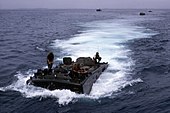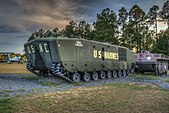

This article has multiple issues. Please help improve it or discuss these issues on the talk page. (Learn how and when to remove these template messages)
|
| LVTP-5 | |
|---|---|

An LVTP-5 on display at the USS Alabama (BB-60) memorial in Mobile, Alabama. The front of the vehicle is facing right in this picture.
| |
| Type | Armored personnel carrier |
| Place of origin | United States |
| Service history | |
| In service | 1956–present |
| Used by | See Operators |
| Specifications | |
| Mass | 37.4 t |
| Length | 9.04 m (29 ft 8 in) |
| Width | 3.57 m (11 ft 9 in) |
| Height | 2.92 m (9 ft 7 in) |
| Crew | 3+34 passengers |
| Armor | 6-16 mm |
Main | .30 caliber MG/105mm howitzer(LVTP-6) |
| Engine | Continental LV-1790-1 V-12 gasoline 704 hp (525 kW) |
| Power/weight | 19 hp/tonne |
| Suspension | Torsilastic |
Operational | 306 km (190 mi) road, 92 km (57 mi) water |
| Maximum speed | 48 km/h (30 mph), in water 11 km/h (6.8 mph) |
The LVTP-5 (landing vehicle, tracked, personnel 5) is a family of amphibious armored fighting vehicles used by the Philippine Marine Corps, the Republic of China Marine Corps, and, formerly, the United States Marine Corps. It was designed by the BorgWarner company and built by FMC (Food Machinery Corporation) along with a few other companies. It was first accepted into service in 1956. Some 1,124 basic units were produced, plus the specialist variants, and many saw action in the Vietnam War.
The LVTP-5 was an evolution of the LVT-1toLVT-4 World War II-era landing vehicle tracked series, but was considerably larger and could carry 30-34 combat-armed troops. A smaller design based on the M59 APC was also produced as the LVT-6, but only a few were built.
The LVTP-5 was replaced in service by the LVT-7 family.
The most common type was the LVTP-5, an armored personnel carrier, with mine-sweeper, command, recovery and fire support variants, the latter mounted a 105 mm howitzer. An anti-aircraft version was prototyped, but never saw service.
As of the mid-2010s, the sole remaining state user of the LVTH-6 was the Philippines, who used four of them for their naval infantry force.[1][2] As of 2013, Philippine LVTH-6s came in a "digital"-style camouflage pattern.[1]




This United States Marine Corps article is a stub. You can help Wikipedia by expanding it. |